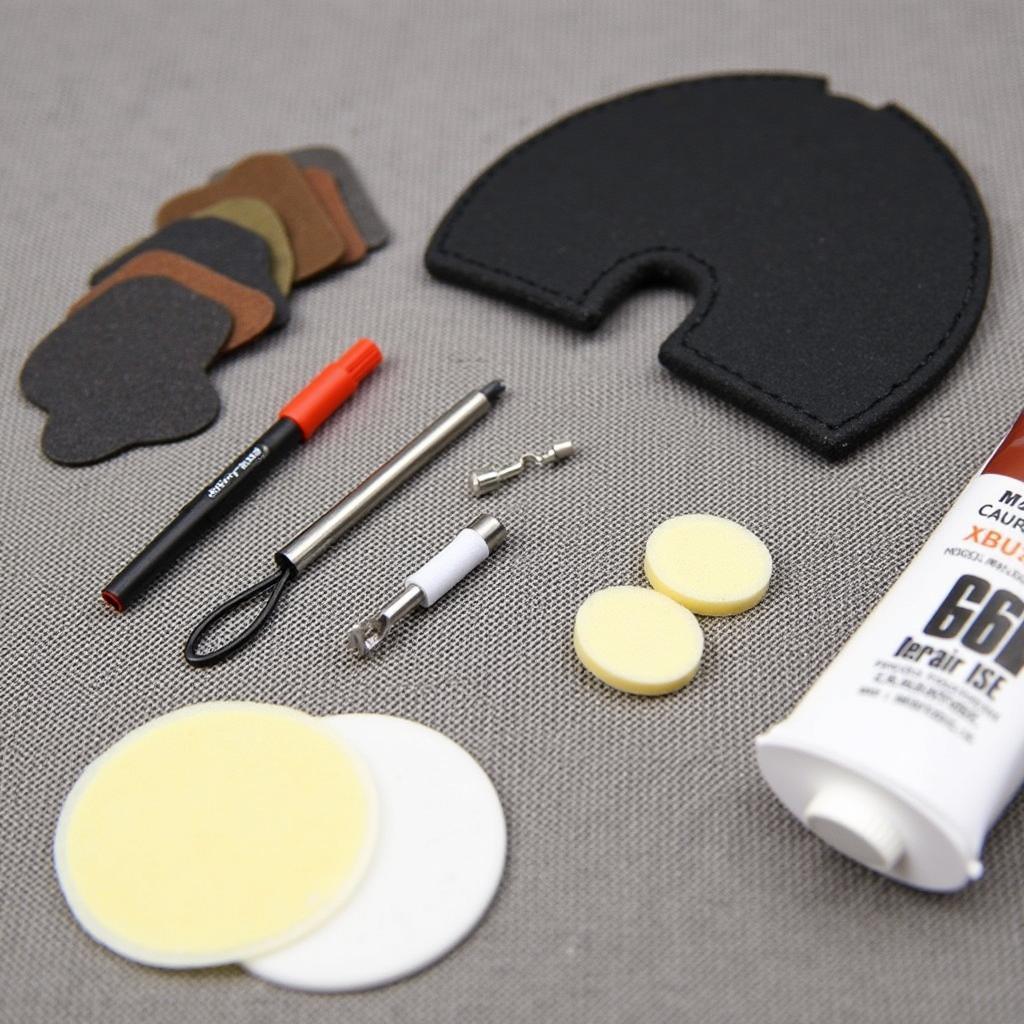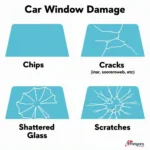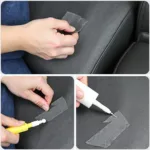Dealing with a hole in your car seat can be frustrating, but it doesn’t have to mean an expensive trip to the upholstery shop. In this comprehensive guide, we’ll walk you through various DIY repair methods to help you restore your car seat’s appearance and comfort.
Assessing the Damage: What Type of Hole Are You Dealing With?
Before diving into repairs, it’s crucial to assess the type and extent of the damage.
- Small punctures or tears: These are typically caused by sharp objects and can often be fixed with simple patching techniques.
- Burn holes: Cigarette burns or similar damage require a different approach, often involving filling the hole before patching.
- Large rips or gashes: Extensive damage might necessitate professional intervention or even seat cover replacement.
Essential Tools and Materials for Car Seat Repair
Having the right tools and materials is crucial for a successful repair. Here’s a basic list:
- Cleaning supplies: Isopropyl alcohol, microfiber cloth, mild soap and water solution.
- Repair kit: Choose a kit specific to your car seat material (leather, vinyl, or cloth).
- Scissors: Sharp fabric scissors for precise cutting.
- Tweezers: Useful for handling small patches and threads.
- Optional: Backing fabric, adhesive spray, heat gun (for leather repair).
How to Repair a Small Hole in a Car Seat
Small holes are the easiest to fix. Here’s a step-by-step guide:
- Clean the area: Using isopropyl alcohol and a clean cloth, thoroughly clean the area around the hole to remove dirt and debris.
- Prepare the patch: Cut a patch from your repair kit slightly larger than the hole, ensuring it matches your car seat material.
- Apply the patch: Follow the instructions provided with your repair kit for adhesive application. Carefully align and press the patch onto the hole, smoothing out any wrinkles or bubbles.
- Allow drying time: Let the patch dry completely as per the kit’s instructions.
How to Repair a Burn Hole in a Car Seat
Burn holes require filling before patching:
- Clean the area: Clean the burned area with a mild soap and water solution. Let it dry completely.
- Fill the hole: Use a leather filler or vinyl repair compound (depending on your seat material) to fill the burn hole. Overfill slightly to allow for sanding.
- Sand the filler: Once dry, gently sand the filled area until it’s smooth and flush with the surrounding surface.
- Patch and blend: Apply a matching patch over the filled area using adhesive. You can use a heat gun (for leather) or a hairdryer (for vinyl) to blend the edges of the patch for a seamless finish.
How to Repair a Hole in Cloth Car Seat
Cloth car seats often require a patching approach similar to leather or vinyl:
- Clean the area: Vacuum and clean the area around the hole with a mild soap and water solution.
- Trim frayed edges: Carefully trim any loose threads or frayed edges around the hole.
- Apply backing fabric (optional): For larger holes, cut a piece of backing fabric slightly larger than the hole. Attach it to the underside of the torn fabric using fabric glue or adhesive spray.
- Apply the patch: Choose a matching patch from your repair kit or use a piece of fabric that closely resembles your car seat upholstery. Apply fabric glue to the back of the patch and carefully align it over the hole.
- Secure the patch: Press firmly on the patch for a few minutes to ensure proper adhesion.
When to Seek Professional Help
While DIY repairs are often effective for minor damage, some situations call for professional expertise:
- Large tears or rips: Extensive damage might be beyond the scope of DIY repair and require professional upholstery work.
- Airbag deployment: If the hole is near an airbag, it’s crucial to have a professional assess any potential safety risks.
- Structural damage: Damage to the seat frame or other underlying components requires professional attention.
Conclusion: Keep Your Car Seats Looking Their Best
Repairing a hole in your car seat can be a manageable DIY project, saving you money and restoring your car’s interior. By following the appropriate techniques for your seat material and the severity of the damage, you can effectively address the issue and prolong the life of your car seats. However, remember that professional help is always recommended for extensive damage or safety concerns.
Frequently Asked Questions (FAQ)
Q: Can I use superglue to repair a hole in my car seat?
A: It’s not recommended. Superglue can create a stiff and noticeable repair that might crack over time. Use adhesives specifically designed for car upholstery.
Q: What’s the best way to prevent holes in my car seats?
A: Be mindful of sharp objects, avoid eating or drinking in your car, and consider using seat covers for added protection.
Q: Can I dye a patch to match my car seat color?
A: While possible, it can be challenging to achieve a perfect color match. Look for pre-dyed patches or consult a professional for color matching.
Q: How long does a car seat repair typically last?
A: With proper care and maintenance, a well-executed repair can last for several years.
Q: What should I do if the hole in my car seat is near an airbag?
A: Contact a professional upholstery shop or your car dealer immediately. Tampering with airbag components can be dangerous.
For more detailed guides on specific car seat repair scenarios, check out our other helpful resources:
- How to repair a small hole in leather car seat
- How to repair a hole in cloth car seat
- How to repair a big hole in leather car seat
- How to repair a car seat burn hole
- How to repair a hole in car seat fabric
Don’t hesitate to reach out if you need assistance! Our dedicated support team is available 24/7 via WhatsApp: +1(641)206-8880 or email: [email protected]. We’re always here to help you with your car repair needs.



